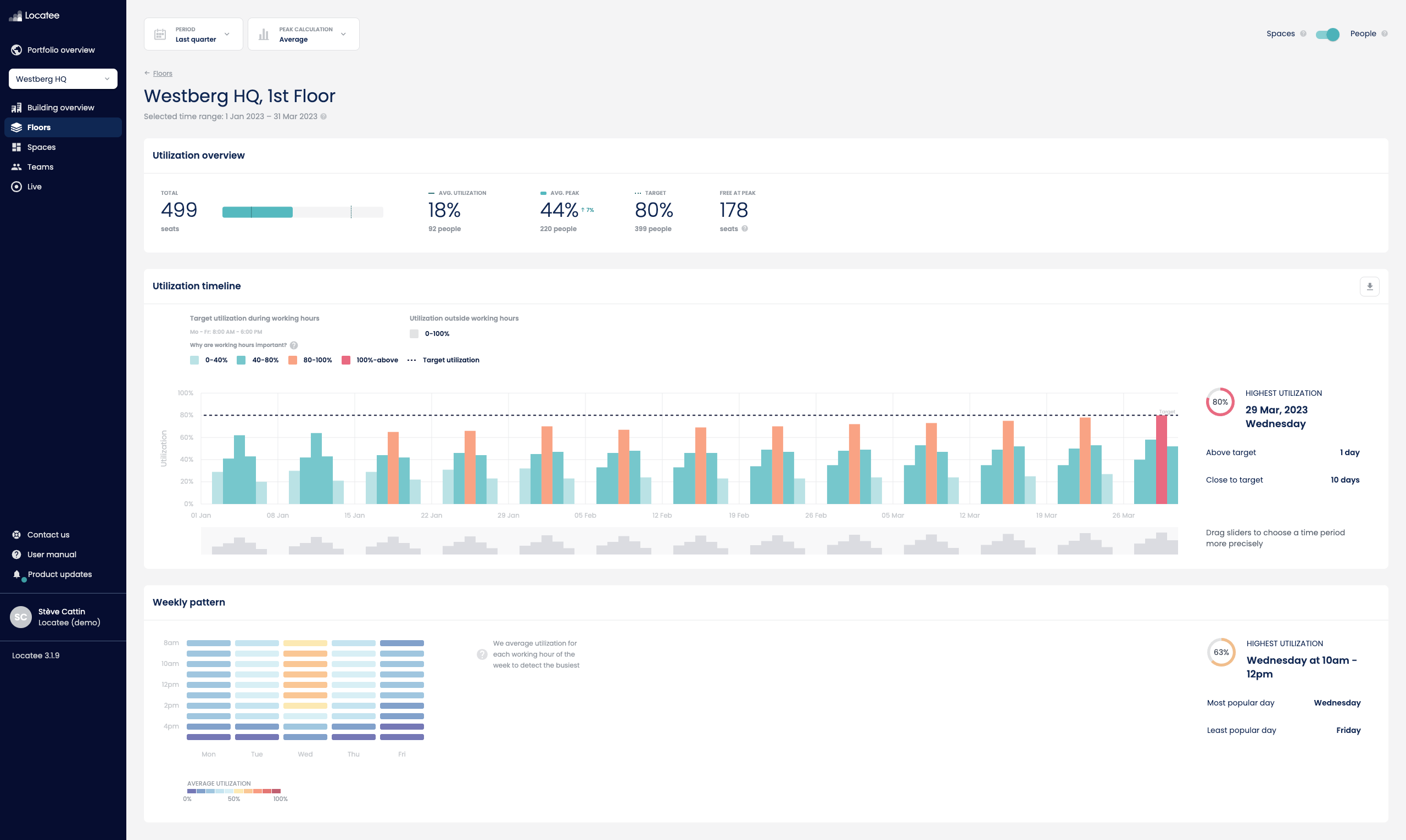Managers of Corporate Real Estate, Facilities & Workplace Experience, Vice Presidents and Heads of Real Estate. Here’s a look at 9 ways your world is evolving as a result of the pandemic and hybrid work evolution in 2022.
- Meetings
- Environmental, Social, & Governance (ESG)
- Data Readiness is Key to Workplace Performance
- Traditional Benchmarking < Company Benchmarks
- Employee Experience Prioritized
- The Greater Role of Flex Space
- Parking is getting Smarter
- Diversity, Equity & Inclusion (DEI)
- CREMs Are More Important Than Ever
1. Meetings
Just as we were getting used to 100% virtual meetings, 2022 will be about mastering hybrid meetings of both in-office and remote participants. We can expect this to be a permanent feature of the hybrid evolution. In fact, some would say the very definition of hybrid work is to describe the way meeting and collaboration is now being done on a global-scale. So it’s time to formulate best practices for How to Run A Great Hybrid Meeting.
Toby Lewis, Senior Manager of Collaboration Strategy at Logitech discussed workplace behavior and meeting practices on The Workplace Leader podcast. He said the pandemic has democratized the use of meeting technology that was originally only used amongst elite organizations. Toby also stated from his research, that it’s about mastering more than just the technology. It’s important to look at all the outside influences on a successful meeting.
2. Environmental, Social, & Governance (ESG)
It’s a smart move on all fronts to keep ESG in mind when making decisions about the workplace. According to CBRE, companies that do so perform better and are more attractive to both internal and external stakeholders. While not the only pillar of any company’s ESG strategy, real estate is a critical component to the external directive for companies to reflect a Triple Bottom Line ethos. One example the workplace can make to impact any company’s ESG strategy is through sustainability efforts.
“As it stands, the real estate sector is responsible for approximately 30% to 40% of worldwide energy consumption and greenhouse gas emissions. At the same time, research shows that the sector faces a major (untapped) potential to improve its carbon footprint through the decarbonisation of building assets, operations and processes.”
—Consultancy.eu
Eliminating unused office space and reducing commutes through remote-work-friendly policies is corporate real estate’s opportunity to make a global impact on the climate crisis in 2022. But as Cushman & Wakefield said in an article, “Corporate real estate can do more.”
3. Data Readiness is Key to Workplace Performance
Corporate Real Estate portfolios were already becoming digitized by the Internet of Things (IoT) pre Covid-19. The result was companies compiling large amounts of data, but having no systematic way of understanding it. A company’s data readiness is their ability to gather data efficiently, accurately and comprehensively. And from that data, capture high-quality, actionable insights that improve the workplace.
Post-outbreak has accelerated the bombardment of CREMs with proptech solutions claiming to support this process of data readiness. By easing all of their pain points and providing the data they need to make critical decisions. Unfortunately, not all proptech companies truly understand corporate real estate enough to provide adequate solutions.
Despite the chaos of having so many emerging options to choose from, workplace analytics and digital solutions are corporate real estate’s key to top performance as a strategic function.
For example, pre-pandemic occupancy was oftentimes determined manually with the help of consultancies. But today’s real estate technology draws on internal company data to capture the occupancy peaks and troughs at the building, floor, teams, and activity-based area levels. Data is increasingly granular. For scalability and better value, CREMs can turn to internet-based solutions that monitor active devices. Then supplement with sensors and/or additional data sources where desired to determine how space and buildings are being utilized.
But even before seeking out a technology solution, the first step is to assess your company’s data readiness. Once you know your starting point, 2022 will be about making improvements to your data-driven workplace strategy from there.
4. Traditional Benchmarking < Company Benchmarks
Corporate Real Estate is moving away from per desk, per cost measurement. As the definition of a successful workplace is changing, new ways of assessing office space are required. Traditional benchmarking is going away. Sectors are becoming less important and workplace leaders are more concerned with their own company benchmarks. The question is how do we do our own in-house benchmarking? What could the future of benchmarking look like in 2022 and beyond?
5. Employee Experience Prioritized
Financial KPIs are traditionally prioritized at the expense of employee experience. As a result of the accelerating and globalized Great Resignation, employee experience is now mission critical in the battle for talent. How to remain aligned with the CFO while achieving new objectives is the evolving challenge. However, even when a company seems 100% focused on employees, there’s still an underlying cost element. Expect Finance to continue to ask ‘Show me the savings.’ And be prepared to show increases in productivity & revenue. See how to bring Employee Experience into focus in the year ahead.
6. The Greater Role of Flex Space
Pre-pandemic, cheaper, flex office spaces had already disrupted the market. Long-term leases, with their disadvantages on real estate costs, agility and productivity per square foot/meter were noticeably losing market share. Capex savings were already being seen. Landlords could just roll over year after year. Workplace managers were already asking ‘Why lock in for 10-15 year leases when you can use flex space?’
As we transition from crisis-driven, fully remote work to hybrid in the new age of working and navigate the uncertainties of covid-19, the industry-wide need for a greater supply of agile, flex space is clear.
Previous forecasts suggested a flex market expansion in the UK office market from 5 percent to 12.5 percent. Now, flex space could take as much as a fifth of total UK office market share by 2023. Large corporates will dominate future demand. And traditional landlords will follow the money and move into offering flex space either directly or by partnering. More on this in a WorkTech Academy Q3 Trend Report.
What will agile office space begin to look like in 2022? Guests on The Workplace Leader podcast discuss how they would improve agility in corporate real estate.
7. Parking is getting Smarter
If the idea of ‘one desk per person’ is outdated in the office, the same applies to the parking lot. With fewer people coming to the office on a daily basis, this is the perfect time to rethink how much space is needed for parking. The parking policy needs to meet the organization’s and the location’s mobility needs, depending on factors like accessibility by public transport, for instance.
But following lower utilization of office space, there will possibly be less demand for parking space as well. That would allow to either reduce car parking space or to re-allocate space for other mobility forms – like a bicycle zone, or spots equipped with charging stations.
Smart parking solutions like Izix can support this shift towards more sharing of resources. But it’s not only about efficiency: Monitoring and sharing information on parking availability can support employee experience and remove friction from coming to the office on specific days. Workplace experience does not stop at the office entrance. In 2022, CRE managers need to look beyond and consider the office commute as well.
8. Diversity, Equity & Inclusion (DEI)
We know that women and BIPOCs (Black, indigenous, and other people of color) were hit hardest by the pandemic which has fueled pressure on the industry to improve opportunities for diverse groups. Recent research on DEI within the corporate real estate field is hard to come by. But if you broaden the scope to commercial real estate, in 2020, a CREW Network study found that very little had changed in the past 15 years with regard to DEI. Men still dominate commercial real estate. Men occupy the vast majority of board and CEO positions and compensation between men and women reflects this. Despite that, “more than half of respondents reported a culture shift…mostly due to mandates from leadership and external pressures from the industry.”
A 2021 CREW Network study found still more signs of progress, though a majority could not escape the negative impacts of the pandemic. The pandemic “stalled” or “derailed progress” for 70% of women in commercial real estate. Of the remaining, 14% were “not impacted” by the pandemic and 16% said the pandemic “leveled the playing field for women.” Both surveys go into more depth on people of color in commercial real estate.
In 2022, CREMs must incorporate DEI into both their corporate real estate solutions and into the industry amongst colleagues.
9. CREMs Are More Important Than Ever
According to Deloitte Consulting, 76% of CEOs reported their organizations will have a reduced need for office space moving forward. If office space demand is declining, does that threaten the viability of a career in corporate real estate, facilities management and in-office workplace experience?
Quite the contrary. Just like the office, corporate real estate is changing, but it’s not dead. Listen to Tracy Hawkins, Twitter’s Vice President of Real Estate & Workplace and Remote Experience, discuss what it’s like to lead the transformation of work. Health and safety is still of primary importance. CREMs are tasked with allowing employees back into the office safely and by law. Additionally, they need to create plans with the expectation that epidemiological crises will continue to occur in the future with higher frequency. Read our 3 tips for how to create a safe and healthy office with data.
The purpose of the office is changing from a place to house employees while they do their work to a place for active and passive collaboration. As well as a place to work with the productivity and wellness boosting amenities you can’t get from home or perhaps anywhere else. Class A space is not declining in demand. Technology and science firms are buying up more office space. The future of work is the hottest topic on the entire world’s mind. In 2022, workplace managers have the greatest opportunity to shed ineffective workplace policies for good. Remnants of the industrial era. And shape our hybrid work era workplaces to be more productive and human-centric.
Locatee can assist you with your workplace strategy efforts and prepare for the coming year. Take our Workplace Insights assessment to find out your data readiness score relative to a 321-company benchmark. Receive personalized recommendations. Then let us walk you through how to implement & scale our digital solution to continuously monitor your space utilization today. You will have the data-driven insights you need to make impactful workplace decisions resulting in company success.

 10’
10’




